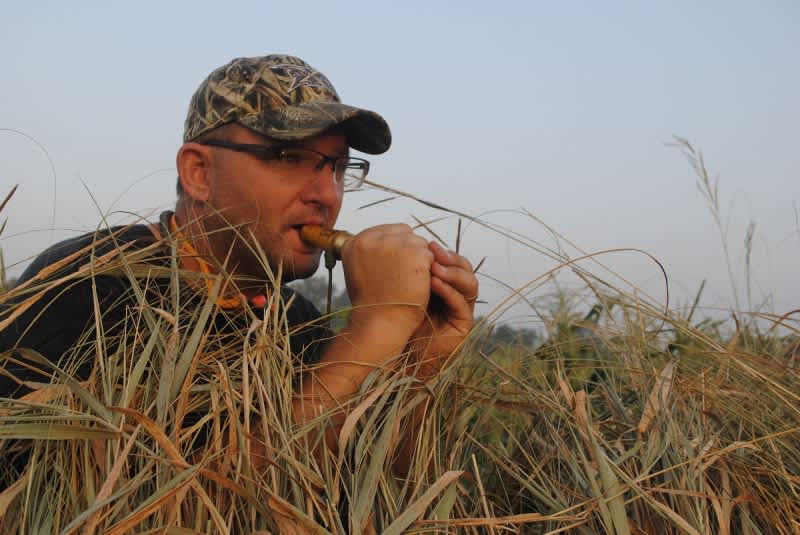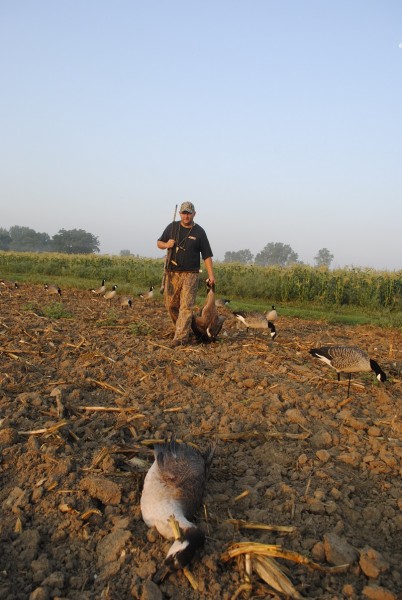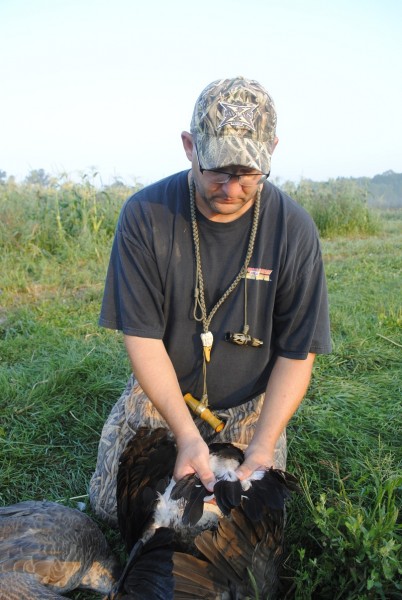Michigan’s Canada Goose Season Could Be Historic
Bob Gwizdz 09.11.15

Were did all the geese come from this year? Joe Robison is scratching his head.
“From my scouting, there seem to be more geese around than last year,” said Robison, a Michigan Department of Natural Resources (DNR) wildlife biologist and hard-core waterfowl hunter. “But our banding was down. We usually band 900 to 1,000, but this year we did 575.
“We had 10 inches of rain in May and 15 inches in June—that’s a record amount,” He continued. “It flooded out a lot of nests.”
One theory that Robison is working on is that the molt migrants—resident Canada geese that for some unknown reason, head north in the summer—have returned earlier than usual this year.
“The majority of molt migrants come back from September 10 to October 1,” Robison explained. “But we did have those 50-degree nights in August, so maybe some of them came back early.”
Well, they were certainly there. We were hunting on a picked sweet corn field, not that far out of town here, that adjoined two other yet-to-be-picked stands of sweet corn. We put up a pair of Zink A-Frame blinds (though the four of us would have fit well enough into one) so that we could have plenty of room to move around on our folding chairs. We could have easily just stood in the standing corn—there’s no such thing as Round Up-ready sweet corn, as far as I can tell and there was plenty of tall grass and various weeds growing up to hide in—but Robison said he didn’t want to take any chances on damaging the crop. I’m sure his landowner appreciates that.
Robison, who’d been scouting the area for a few days, said he’d seen around 100 geese using the field. We put out five dozen Avian X decoys and settled in.
The decoys were deployed in what I thought was an unusual pattern; typically Robison leaves an opening in the middle of the spread where he hoped to entice the birds to come in. But there was no such hole in this spread.

“I was trying to put them out like I saw them in the field the last couple of days,” Robison said. “They were all standing around in kind of a big circle.
“If you have 40 geese going into as field and you put out 100 decoys, it doesn’t look natural. If you put out fewer than are using the field, there’s birds in there, but it doesn’t look like they’re all there all there yet.”
We didn’t see anything for an hour, something that might have freaked out some hunters, but rolled right off of Robison’s camo.
“The geese around here are lazy,” he said. “They’re coming in here from ponds at apartment complexes and housing developments. They’re probably feeding on stuff that the residents are feeding them. And they’re not being bothered on the roosts like some birds are other places. On a lot of places, guys are going out to hunt and they’re pushing birds off the roosts.
“Other places you have to be out and set up before sunrise, especially if it’s hot,” Robison continued. “In September it’s usually hot and sunny, but this year, the week before the season was cool and overcast and the birds flew all day long. I came out here one day to help the farmer cut his wheat stubble and the birds were coming in at 11 o’clock.”
A little more than an hour after shooting time, a single came winging toward us, circled the field twice, but came just a little bit too close for its own good. Randy Turner dropped it with a single shot.
It was the start of something good. Ten minutes later, a foursome came in and though they never committed to landing, they were close enough that we killed three of them. A short time later, a bigger bunch—I’d say about a dozen—did the same thing; they didn’t want to finish but they flew close enough. We killed seven of them.
Meanwhile, there were plenty in the air that didn’t even give us a look and several more flights that gave us a cursory look, then headed off elsewhere.

Robison, who is an excellent caller, hailed them at a distance, but then backed way off as they approached our set.
“When you’re in a spot where the geese are coming, you don’t really need to call,” he said. “Just make some basic clucks and moans.”
What is most amazing about this hunt is that these giant Canadas—the DNR estimates they number more than 300,000 in Michigan this year, near an all-time high—were once thought to be extinct. Michigan’s goose population was rebuilt from DNR game-farm stock that came from a small flock of giants imported from Minnesota. Now, there are more geese than the DNR’s management goal (175,000 to 250,000), hunters get 107 days of goose season, and last year they took 140,000. Just amazing.
The birds kept coming in small bunches. Twice a flock was within shooting range, but over the sweet corn, and Robison declined to call the shot rather than drop them in the crops and risk damaging the corn. Finally, a quintet swung out in front of us; we killed four of them.
That gave us 15, still shy of our 20-bird allotment, but good enough, Robison said, as the farmer wanted to work in his fields and Robison told him we’d be out of there by 9:30.
We had four more groups trying to come in while we were picking up the decoys.
You can never tell how a season’s going to progress. But given the number of birds around, I’d guess that if the weather cooperates, we could see a record goose harvest in Michigan this year.
For more information on Michigan hunting go to michigan.org. Click here to purchase a Michigan hunting license online.
This article was produced in partnership with Pure Michigan.

